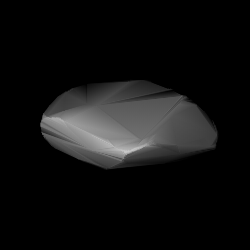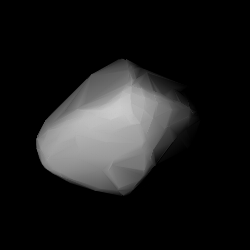Athalia, provisional designation 1903 ME, is a carbonaceous Themistian asteroid from the outer regions of the asteroid belt, approximately 40 kilometers in diameter. It was discovered on 20 September 1903, by German astronomer Max Wolf at the Heidelberg Observatory in southwest Germany. The asteroid was named after the ancient Judahite queen Athaliah.
La Paz, provisional designation 1923 PD, is a carbonaceous asteroid from the outer region of the asteroid belt, approximately 40 kilometers in diameter. It was discovered on 31 October 1923, by German astronomer Max Wolf at the Heidelberg-Königstuhl State Observatory and named after the city La Paz in Bolivia.
1151 Ithaka, provisional designation 1929 RK, is a carbonaceous asteroid from the inner regions of the asteroid belt, approximately 14 kilometers in diameter. It was discovered by Karl Reinmuth at the Heidelberg-Königstuhl State Observatory in 1929, and later named for the Greek island of Ithaca.
1159 Granada, provisional designation 1929 RD, is a dark background asteroid and relatively slow rotator from the inner regions of the asteroid belt, approximately 30 kilometers in diameter. It was discovered on 2 September 1929, by astronomer Karl Reinmuth at the Heidelberg Observatory in southwest Germany. The asteroid was named for the Spanish city and province of Granada.
11277 Ballard (provisional designation 1988 TW2) is a Phocaea asteroid from the inner regions of the asteroid belt, approximately 6.3 kilometers (3.9 miles) in diameter. It was discovered on 8 October 1988, by American astronomer couple Carolyn and Eugene Shoemaker at the Palomar Observatory in California. The assumed S-type asteroid has a rotation period of at least 10 hours. It was named for American marine scientist Robert Ballard.
1267 Geertruida, provisional designation 1930 HD, is a carbonaceous background asteroid from the inner regions of the asteroid belt, approximately 20 kilometers in diameter. Discovered by astronomer Hendrik van Gent at Johannesburg Observatory in 1930, the asteroid was later named after Geertruid Pels, sister of Dutch astronomer Gerrit Pels.
1452 Hunnia, provisional designation 1938 DZ1, is a carbonaceous Meliboean asteroid from the outer regions of the asteroid belt, approximately 20 kilometers in diameter. It was discovered on 26 February 1938, by Hungarian astronomer György Kulin at the Konkoly Observatory in Budapest. The asteroid was named in honor of the Hungarian nation.
2324 Janice, provisional designation 1978 VS4, is a dark background asteroid from the outer regions of the asteroid belt, approximately 25 kilometers (16 miles) in diameter. It was discovered on 7 November 1978, by American astronomers Eleanor Helin and Schelte Bus at the Palomar Observatory in California. The asteroid was named for Janice Cline at Caltech. The presumably C-type asteroid has a rotation period of 23.2 hours.
5385 Kamenka, provisional designation 1975 TS3, is a background asteroid from the outer regions of the asteroid belt, approximately 16 kilometers (10 miles) in diameter. It was discovered on 3 October 1975, by Soviet astronomer Lyudmila Chernykh at the Crimean Astrophysical Observatory in Nauchnij, on the Crimean peninsula. The presumed C-type asteroid has a rotation period of 6.68 hours. It was named for the Ukrainian town of Kamianka.
4944 Kozlovskij, provisional designation 1987 RP3, is a carbonaceous Witt asteroid from the central regions of the asteroid belt, approximately 10 kilometers (6 miles) in diameter. It was discovered on 2 September 1987, by Soviet astronomer Lyudmila Chernykh at the Crimean Astrophysical Observatory in Nauchnij, on the Crimean Peninsula. The asteroid was named for Russian opera singer Ivan Kozlovsky.
6255 Kuma, provisional designation 1994 XT, is a carbonaceous asteroid from the central region of the asteroid belt, approximately 22 kilometers in diameter. It was discovered on 5 December 1994, by Japanese astronomer Akimasa Nakamura at Kuma Kogen Astronomical Observatory on the Island of Shikoku, Japan. It was named after the Japanese town of Kumakōgen.
1383 Limburgia, provisional designation 1934 RV, is a carbonaceous asteroid from the outer region of the asteroid belt, approximately 23 kilometers in diameter. It was discovered on 9 September 1934, by Dutch astronomer Hendrik van Gent at the Leiden Southern Station, annex to the Johannesburg Observatory in South Africa. It is named for the Dutch province Limburg.
1303 Luthera, provisional designation 1928 FP, is a dark asteroid and the parent body of the Luthera family, located in the outermost regions of the asteroid belt. It measures approximately 90 kilometers in diameter. The asteroid was discovered on 16 March 1928, by astronomer Friedrich Schwassmann at the Bergedorf Observatory in Hamburg, Germany, and later named after German astronomer Robert Luther.
1692 Subbotina, provisional designation 1936 QD, is a dark background asteroid from the central region of the asteroid belt, approximately 37 kilometers in diameter. The carbonaceous Cg-type asteroid has a rotation period of 9.2 hours. It was discovered by Grigory Neujmin at the Crimean Simeiz Observatory in 1936, and later named after Soviet mathematician and astronomer Mikhail Subbotin.
2169 Taiwan, provisional designation 1964 VP1, is a carbonaceous Astridian asteroid from the central regions of the asteroid belt, approximately 17 kilometers in diameter. It was discovered on 9 November 1964, by astronomers at the Purple Mountain Observatory near Nanking, China. It was named for Taiwan.
3823 Yorii, provisional designation 1988 EC1, is a carbonaceous asteroid from the outer region of the asteroid belt, approximately 11 kilometers in diameter.
4760 Jia-xiang, provisional designation 1981 GN1, is a background asteroid from the inner regions of the asteroid belt, approximately 5 kilometers (3 miles) in diameter. It was discovered on 1 April 1981, by astronomers at Harvard University's Oak Ridge Observatory in Massachusetts, United States. The presumed stony S-type asteroid was named after Chinese astronomer Zhang Jiaxiang. It has a rotation period of 14.96 hours.

1632 Sieböhme, provisional designation 1941 DF, is an asteroid and relatively slow rotator from the middle region of the asteroid belt, approximately 27 kilometers in diameter. It was discovered on 26 February 1941, by German astronomer Karl Reinmuth at Heidelberg Observatory in southern Germany. It was later named after ARI-astronomer Siegfried Böhme.

1422 Strömgrenia, provisional designation 1936 QF, is a stony Florian asteroid from the inner regions of the asteroid belt, approximately 5.5 kilometers in diameter. It was discovered on 23 August 1936, by German astronomer Karl Reinmuth at Heidelberg Observatory in southern Germany, and named after Swedish-Danish astronomer Svante Elis Strömgren.
15224 Penttilä, provisional designation 1985 JG, is a dark background asteroid from the inner regions of the asteroid belt, approximately 8 kilometers in diameter. It was discovered on 15 May 1985, by American astronomer Edward Bowell at Lowell's Anderson Mesa Station in Arizona, United States. The likely elongated asteroid has a rotation period of 4.4 hours. It was named after planetary scientist Antti Penttilä at the University of Helsinki.


